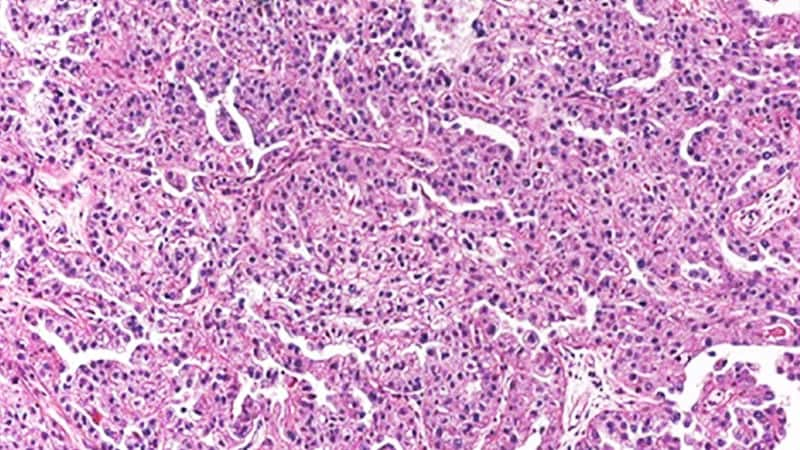New Role for Olaparib in BRCA Ovarian Cancer in Neoadjuvant Setting
Core Concepts
Olaparib shows promise in neoadjuvant ovarian cancer treatment.
Abstract
The study explores the potential of olaparib, a PARP inhibitor, in the neoadjuvant setting for ovarian cancer patients with BRCA mutations. Key highlights include:
- Feasibility of olaparib in neoadjuvant setting.
- Optimal tumor reduction post-surgery.
- Positive outcomes after two cycles.
- Potential for targeted therapies earlier in treatment.
- Favorable responses to olaparib treatment.
- Reduction in chemotherapy cycles.
- Adverse events and patient interest in PARP inhibitor monotherapy.
- Ongoing molecular assessment of biomarkers.
- Role of neoadjuvant PARP inhibitor therapy.
Customize Summary
Rewrite with AI
Generate Citations
Translate Source
To Another Language
Generate MindMap
from source content
Visit Source
www.medscape.com
New Role for Olaparib in BRCA Ovarian Cancer in Neoadjuvant Setting
Stats
"New results show that giving olaparib in the neoadjuvant setting is feasible, with all participants completing the planned two cycles."
"Of the 93% of women who underwent subsequent surgery, all achieved optimal tumor reduction."
"At a median follow up of 11.7 months, median progression-free survival has not yet been reached."
Quotes
"This study provides a potential template for how we might vet targeted therapies earlier in the treatment continuum." - Shannon N. Westin
"Of the 14 patients who went to surgery, 86% of patients had a complete cytoreduction with 1 patient who had a pathologic complete response." - Gina Mantia-Smaldone
Key Insights Distilled From
by Roxanne Nels... at www.medscape.com 03-30-2023
https://www.medscape.com/viewarticle/990257
Deeper Inquiries
How might the success of olaparib in the neoadjuvant setting impact the standard of care for ovarian cancer treatment?
The success of olaparib in the neoadjuvant setting could potentially revolutionize the standard of care for ovarian cancer treatment. By demonstrating feasibility and favorable outcomes in the neoadjuvant setting, olaparib opens up new possibilities for earlier intervention and potentially more effective treatment strategies. If further studies confirm the efficacy of neoadjuvant PARP inhibitor therapy, it could become a crucial component of the treatment paradigm for ovarian cancer, especially in patients with specific biomarkers like BRCA mutations. This shift towards neoadjuvant therapy could lead to improved outcomes, reduced need for extensive chemotherapy, and better overall quality of life for patients.
What potential challenges or drawbacks could arise from shifting to neoadjuvant PARP inhibitor therapy?
While the prospect of neoadjuvant PARP inhibitor therapy is promising, there are several potential challenges and drawbacks that could arise from this shift in treatment approach. One significant challenge is the need for careful patient selection to ensure that only those who are most likely to benefit from this therapy receive it. Additionally, there may be concerns about the development of resistance to PARP inhibitors over time, which could limit their long-term effectiveness. Another drawback is the possibility of increased financial burden, as PARP inhibitors can be costly and adding them to the treatment regimen earlier in the disease course may impact healthcare costs. Furthermore, there may be logistical challenges in terms of monitoring patients closely for adverse effects and response to treatment in the neoadjuvant setting.
How can ongoing molecular assessment of biomarkers improve personalized treatment approaches for ovarian cancer patients?
Ongoing molecular assessment of biomarkers plays a crucial role in improving personalized treatment approaches for ovarian cancer patients. By analyzing specific biomarkers like BRCA mutations, RAD51C, RAD51D, or PALB2 genes, healthcare providers can tailor treatment strategies to individual patients based on their unique genetic profiles. This personalized approach allows for targeted therapies like PARP inhibitors to be used more effectively, maximizing treatment efficacy while minimizing potential side effects. Molecular assessment also enables clinicians to monitor treatment response, detect early signs of resistance, and make real-time adjustments to the treatment plan as needed. Overall, ongoing molecular assessment of biomarkers empowers healthcare providers to deliver precision medicine and optimize outcomes for ovarian cancer patients.
0
